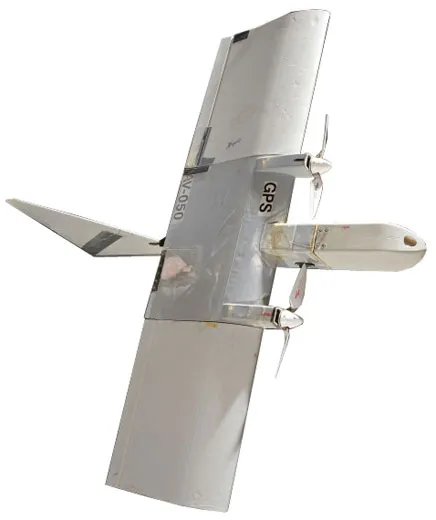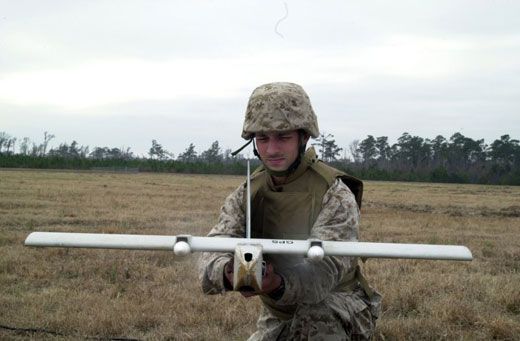Under the Radar with Unmanned Aerial Vehicles
The five-pound RQ-14A takes high-tech reconnaissance to new heights
/https://tf-cmsv2-smithsonianmag-media.s3.amazonaws.com/filer/unmanned-aerial-vehicle-Dragon-Eye-631.jpg)
Early on warm summer evenings in the small New Jersey town where I grew up, my father would take me to the ball field behind Benjamin Franklin Elementary School. The buzzing in the air was produced not by my home state's hummingbird-size mosquitoes, but by squadrons of model airplanes, their single propellers powered by tiny gasoline engines, their flights radio-controlled by sons and fathers on the ground. For neighbors within earshot, the little planes' rasping sound must have been an annoyance, but for me and other kids like me, it was the sound of the future, when we would all be pilots in full-size airplanes, dueling in the skies with America's enemies. (I ended up as a ground-pounding marine—a story for another time.)
But many years after those summer nights, things have taken a surprising turn. Today, those model airplanes, in far more complicated and vastly more expensive forms, have gone to war. At the Smithsonian's National Air and Space Museum (NASM), a display of six unmanned aerial vehicles (UAVs) demonstrates what happens when the little airplanes of my childhood get serious. Take the five-pound, 45-inch wingspan AeroVironment RQ-14A "Dragon Eye." Launched by hand, or with a bungee cord, the tiny scout plane is controlled by GPS coordinates entered into its guidance system with a standard laptop computer. Once aloft on its mission—to transmit video images of territory lying ahead of a marine infantry or transport unit—the little scout is completely autonomous.
"The video is received in special eyeglasses worn by one of the two marines who operate the plane," says NASM curator Dik Daso. "Taking the pilot out of the plane [in reconnaissance missions] has been a concern for a long time," says Daso, a former Air Force reconnaissance pilot. "All sorts of cosmic stuff can be done when the person is out of the vehicle. You can design things that are really stealthy."
The pilotless Dragon Eye keeps marines from having to move into what may be hostile territory without knowing what's ahead. Two tiny video cameras in the nose cone—one positioned to look down, the other to look to the side—give an accurate view of what's on the ground, precise enough for mortar fire to be directed at perceived threats.
According to Ben Kristy, aviation curator at the National Museum of the Marine Corps near Quantico, Virginia, the Dragon Eye is "a force multiplier. It helps alleviate the danger of what's over the hill." He says the craft's two propellers and two electric motors allow it to stay up for between 30 minutes and an hour, depending on the wind. "The goal is 60 missions, and each battalion gets three airframes and spare parts."
Ron Colbow, a computer scientist and systems engineer with the Naval Surface Warfare Center in Dahlgren, Virginia, now on assignment to the Marine Corps Warfighting Lab in Quantico, helped develop the Dragon Eye. "We specifically made the system so that any marine trained to use Windows operating systems could fly the plane," he says. "It's a very forgiving aircraft. When it makes a belly landing on its Kevlar underside, the nose, tail and wings come off by design, to dissipate energy. And it can take a beating." On duty in Afghanistan, "the one on display at Air and Space hit a telephone pole, so the marines patched it with duct tape and sent it up again."
Unmanned and remote-controlled aircraft have a surprisingly long history. "The technology that goes into a UAV has been around for 100 years," Daso says, "since before World War I." Henry Ford and other top engineers helped to design both full-size and scale planes that were radio-controlled. The Great War ended before any of them could go into action. Now, Daso adds, "there are so many UAVs in the air, it's hard to keep track of them all."
The battered Dragon Eye on display is one of some 6,000 deployed since 2002, at about $80,000 apiece. Today, smaller and lighter models are being introduced, new "bugs," as they are known, that can fly into village compounds and look around at human eye level. Dragon Eye is being phased out; only about 100 remain in action. "There are unmanned aerial vehicles in development that fly like insects," says Colbow. "We'll see these systems doing more and more."
So why did he decide to include this duct-taped veteran in the UAV display? "I wanted it for all the kids who, like me, have built things like this."
Owen Edwards is a freelance writer and author of the book Elegant Solutions.
/https://tf-cmsv2-smithsonianmag-media.s3.amazonaws.com/accounts/headshot/Owen-Edwards-240.jpg)


/https://tf-cmsv2-smithsonianmag-media.s3.amazonaws.com/accounts/headshot/Owen-Edwards-240.jpg)